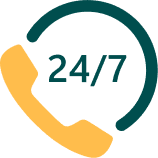On-Demand Outsourcing BPO Services for Healthcare Providers With 24/7 Coverage!
Save up to 70% on staffing costs!
Browse Specialty Staffing ServicesAre Your Remote Medical Scribes HIPAA Secure When Handling Patient PHI?

It was a busy Monday morning. Dr. Nguyen was juggling back-to-back appointments when he noticed something alarming: a patient note from his remote scribe included sensitive mental health details—typed into the wrong chart.
It wasn’t malicious. Just a mistake. But it raised serious questions about compliance, data safety, and who’s really accountable when remote scribes manage protected health information (PHI) from afar.
Remote medical scribes can make clinical workflows faster and more efficient—but without HIPAA-secure processes, they can also become a hidden risk.
Why It Matters?
Remote medical scribes work directly inside your EHR, documenting clinical encounters in real-time. That means they have access to highly sensitive patient data—from diagnoses to medications to lab results.
If that information is mishandled—even unintentionally—your practice could face:
-
HIPAA violations and fines
-
Patient trust issues
-
Audit risks
-
Operational slowdowns due to rework or investigations
Staffingly ensures your remote scribe team is more than just fast—they’re trained, monitored, and compliant at every click and keystroke.
How Remote Medical Scribing Works?
Remote scribes listen in on live or recorded patient visits and document the interaction directly into your EHR. Their responsibilities often include:
-
Charting SOAP notes
-
Capturing HPI, ROS, and physical exam findings
-
Entering CPT and ICD codes (if applicable)
-
Updating medication lists and allergies
-
Assisting with documentation templates and macros
All of this requires direct access to PHI—meaning HIPAA compliance isn’t optional, it’s critical.
What’s Protected Under HIPAA?
When scribes work remotely, they interact with multiple forms of protected health information (PHI), such as:
-
Patient names and DOBs
-
Medical histories and diagnoses
-
Treatment plans
-
Lab/test results
-
Insurance information
-
Behavioral or mental health notes
Every scribe interaction must follow strict Privacy Rule and Security Rule guidelines—including how data is accessed, stored, and transmitted.
When HIPAA Risks Occur in Remote Scribing?
HIPAA violations don’t always come from bad intent—they often stem from:
-
Unsecured Wi-Fi connections at the scribe’s location
-
Improper access controls or shared logins
-
Untrained scribes unaware of PHI handling protocols
-
Documentation into the wrong chart
-
Storing notes locally instead of through approved systems
That’s why Staffingly builds safeguards into every scribe engagement.
The Role of Technology in HIPAA-Secure Scribing
Staffingly uses tech-enabled workflows to ensure every scribe session is secure:
-
EHR access via VPN or whitelisted IPs
-
Multi-factor authentication for every login
-
Session recording and activity logs for accountability
-
Device encryption and endpoint protection
-
No local storage policies enforced via remote management tools
Our VAs use HIPAA-compliant tools only—no shortcuts, no gray zones.
Common Challenges (and How Staffingly Solves Them)

Staffingly’s Role in Secure Remote Scribing
Here’s how we keep your clinical documentation secure and compliant:
-
Certified HIPAA training for every scribe, with monthly refresher sessions
-
Secure communication protocols using encrypted platforms
-
No BYOD (Bring Your Own Device)—Staffingly provides secured, pre-approved devices
-
Real-time supervision and periodic documentation audits
-
Dedicated account manager to respond to any compliance concern within 24 hours
Staffingly’s remote scribes don’t just chart fast—they chart safe.
What Did We Learn?
Remote medical scribes can be a game-changer for provider productivity—but without HIPAA-secure systems, they can also introduce serious risk.
Staffingly eliminates that risk with training, technology, and tight controls, giving you a remote scribe solution that’s built for compliance and designed for care.
What People Are Asking
1. Are remote scribes allowed to handle PHI under HIPAA?
Yes—as long as they follow HIPAA’s Privacy and Security Rules. Staffingly ensures full compliance with BAA-covered services and PHI protocols.
2. What’s the biggest HIPAA risk with remote scribes?
Most violations stem from unsecured connections, device misuse, or charting into the wrong patient file. Staffingly mitigates this with training and tech safeguards.
3. Do scribes need to use special software or hardware?
Yes. Staffingly scribes use encrypted devices, VPN access, and MFA for all logins. No personal devices or unsecured apps allowed.
4. What if a scribe accidentally documents in the wrong chart?
We implement chart-verification protocols and immediate correction workflows. All actions are traceable in our audit logs.
5. How does Staffingly train its scribes on HIPAA?
Every scribe goes through a certified HIPAA training program, signs compliance agreements, and completes monthly refresher modules.
Disclaimer
For informational purposes only; not applicable to specific situations.
For tailored support and professional services,
Please contact Staffingly, Inc. at (800) 489-5877
Email : support@staffingly.com.
About This Blog : This Blog is brought to you by Staffingly, Inc., a trusted name in healthcare outsourcing. The team of skilled healthcare specialists and content creators is dedicated to improving the quality and efficiency of healthcare services. The team passionate about sharing knowledge through insightful articles, blogs, and other educational resources.
 Book a Demo to Build Your Team Today!
Book a Demo to Build Your Team Today!

 Read Case Studies
Read Case Studies 



 Virtual Medical Assistants
Virtual Medical Assistants



